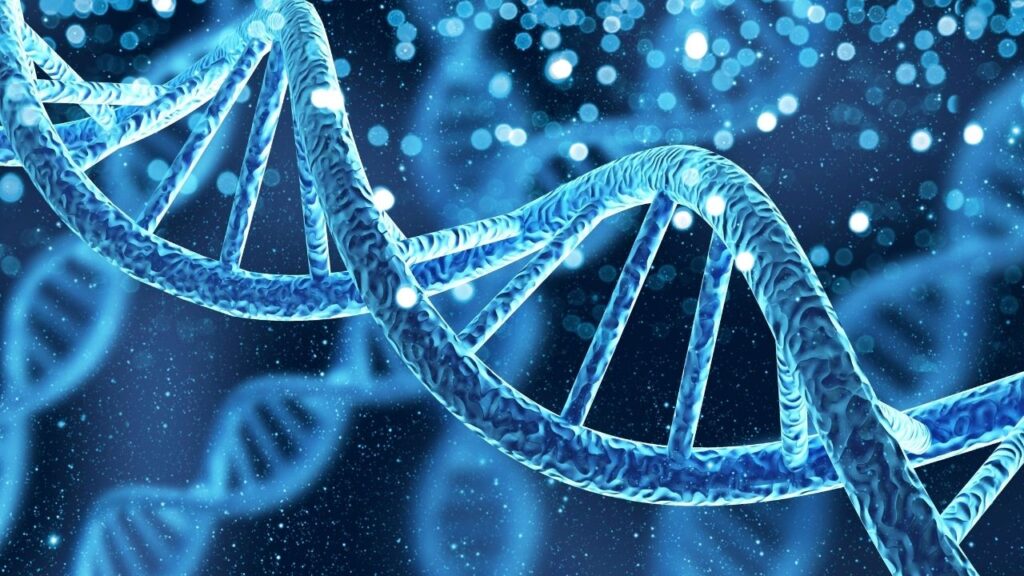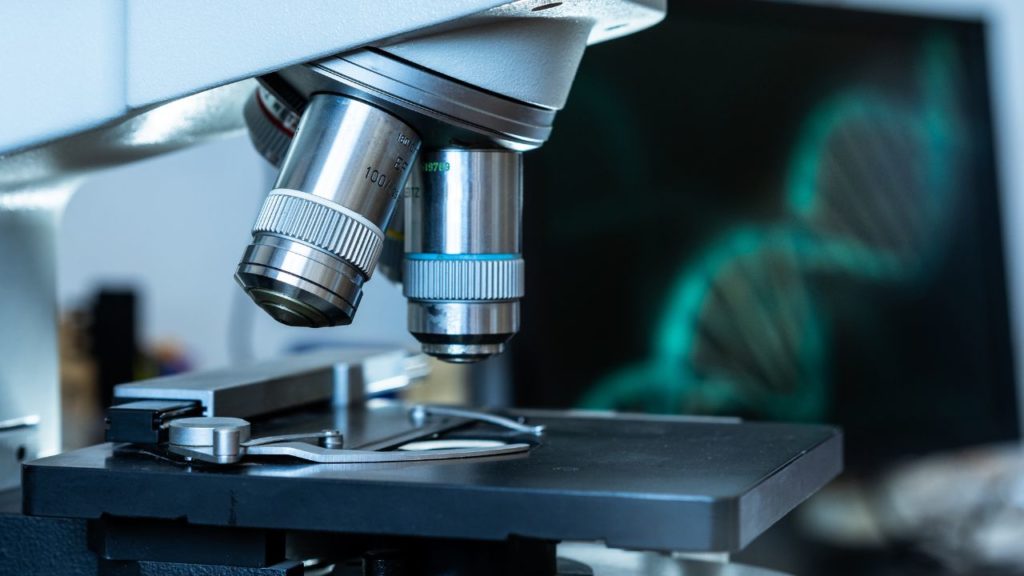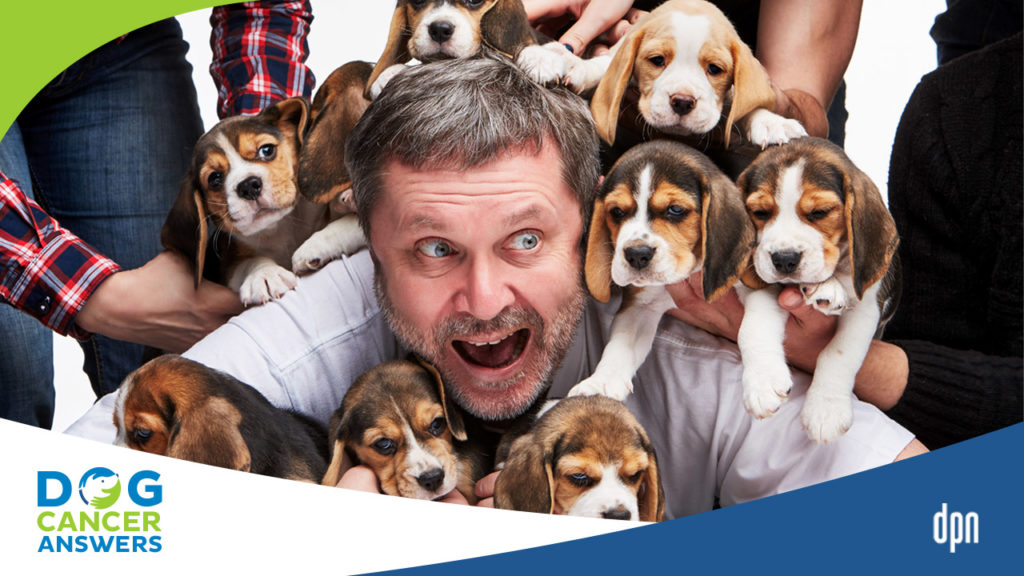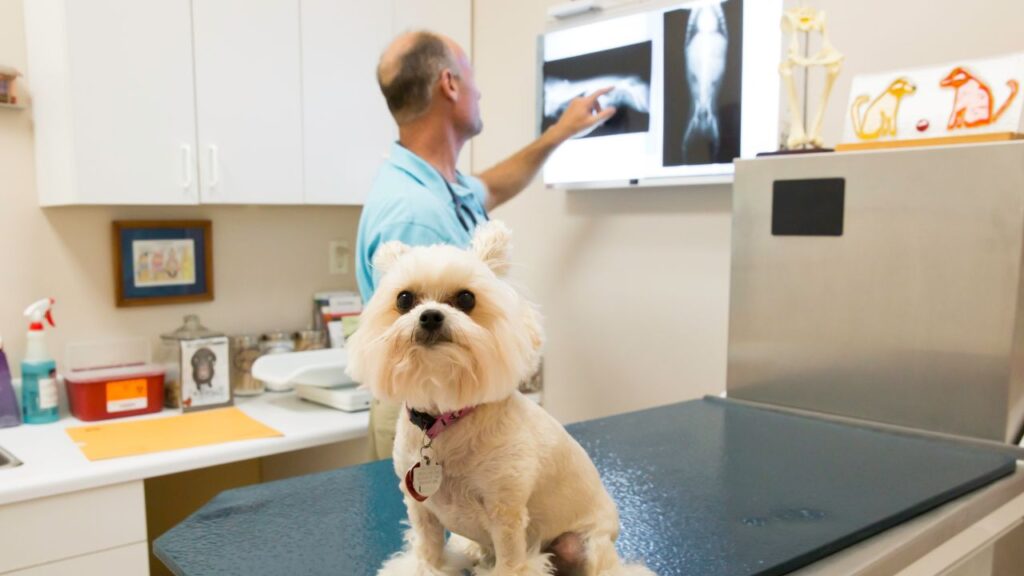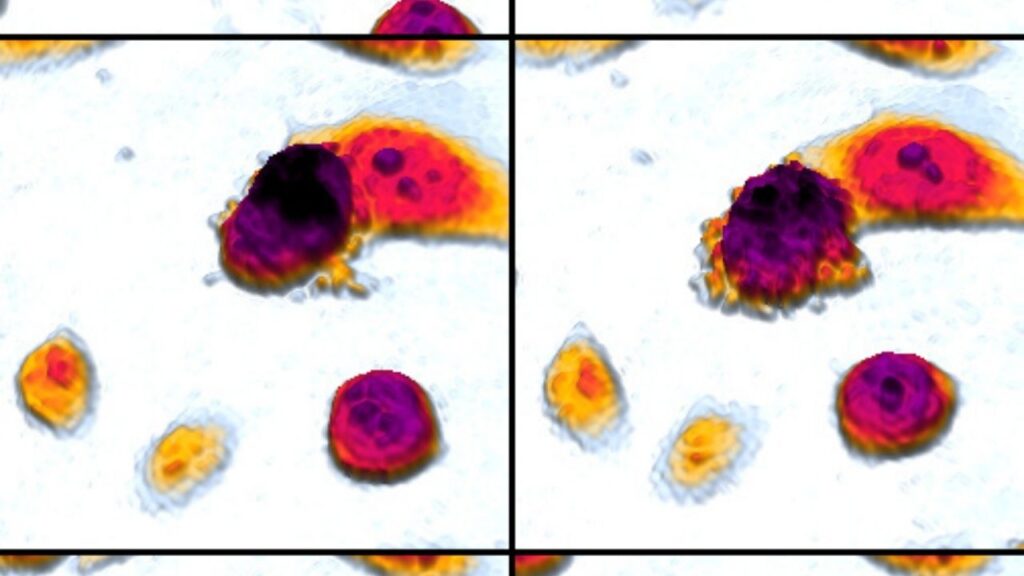Changes in the DNA of some of your dog’s cells can greatly impact their cancer risk and its characteristics.
Key Takeaways
- A genetic mutation can cause cancer.
- Genetic mutation means that a change has occurred in the DNA that changes how the genes and proteins in the body behave.
- There are dog cancers that are genetic, or that can be genetic. Some examples include osteosarcoma, lymphoma, and kidney cancer.
Let’s Start at the Beginning: About Genes and DNA
Your dog’s genome is the collective total of all their DNA. Just like a blueprint for a house, DNA codes for every trait about them, from eye color and height to temperament and cancer risk.
Just like a house blueprint has many pages and lots of detail, DNA’s “blueprint” has a lot of detail, too.
Nucleotides, the Building Blocks of DNA
DNA is composed of four building blocks called nucleotides. Nucleotides are denoted by the letters “A”, “C”, “T”, and “G”.
Strung together, these nucleotides make up the nucleic acids DNA and RNA. A particular stretch of nucleic acids makes up a gene.
Genes Hold Codes for Proteins
A gene is a segment of DNA that is in charge of a specific trait or function in the body.
Each gene is basically an “instruction manual” that tells a cell how to make the proteins it needs to function.1
The nucleotides within the gene are grouped into clusters of three, called codons (for example, ACT and GGA are both codons). Each codon codes for an amino acid.
Multiple amino acids can be found in one gene, and together these form the foundation of a protein that is assigned to do a particular “job” in the cell.
The Jobs Proteins Do
You might think of protein as just a type of nutrient, and it is. But on the cellular level, protein is much more. Protein is, in a way, everything. Proteins are responsible for nearly every body process. They organize, shape, manufacture, break down, clean up, and maintain. Proteins receive signals from the environment and direct the body’s response.13
If your dog is alive, it is proteins that are responsible for that life!
How Genes Are Passed On
Your dog has two copies of each gene – one they inherit from their mother and one they inherit from their father.
The nucleotides in each of these inherited genes can be different from one another.
When two genes have different nucleotides, they may produce different amino acids, which produce different proteins, which means different function. A relatively small difference in genes can result in a completely different trait altogether. These differences create variations of each gene.
NIH Geneticist Elaine Ostrander, PhD, talks about how understanding dogs can help us understand people, and vice versa.
Gene Mutations
Genetic mutations are changes in the sequence of DNA.6 While the word “mutation” may have a negative connotation, they’re actually incredibly important in the biological world. Mutations are the main cause of observed genetic diversity and are a powerful force of adaptation and evolution for species and organisms.6
A mutation can maintain, increase, or decrease fitness, or how well an organism survives.7 For example, a mutation that results in increased fitness increases the likelihood that the organism with that mutation lives longer. Alternatively, an organism with a mutation that decreases its fitness will presumably not live as long.
How Genetic Mutations Happen
There are two primary ways that mutations can occur – hereditarily and spontaneously.
Hereditary mutations occur in germ-line cells (the cells that make sperm in males and eggs in females). As the name suggests, your dog inherits these mutations from their parents.11 This is why cancer can be hereditary.
Spontaneous mutations occur in somatic cells (cells that are found in your dog’s present body that are not germ-line cells). These mutations can be acquired by your dog in the womb and throughout their lifetime. There are many environmental influences that can cause these mutations to occur, such as exposure to UV light or chemicals.
A spontaneous mutation in a gene in one cell does not “spread” to the same genes in other cells. Instead, when a mutation occurs in a gene in one of the trillions of cells in your dog’s body, that cell’s daughter cells will inherit the mutation.11 As those daughter cells reproduce, they pass the gene mutation down to their daughter cells, and so on, and so on.
For example, if the initial mutation occurs in a kidney cell, over time you will see more and more kidney cells with that mutation, but you won’t see any stomach cells with it.
Three Kinds of Genetic Mutations
There are several different kinds of mutations that can occur in a DNA sequence. They can broadly and simplistically be clumped into three primary types:6
- Insertion is when anything ranging from one nucleotide to an entire segment of nucleic acids is inserted into a stretch of DNA.
- Deletion is when anywhere from one nucleotide to the entire gene itself is removed from a stretch of DNA.
- Substitution is when one or more nucleotides get switched out for the same number of different nucleotides (for example, AGT becomes CAT, or GC becomes TA). When only one nucleotide is involved, it is called a point mutation. A point mutation is typically of low consequence because the function of the gene may not change.
Genes Can Jump: Transposable Elements
You may also hear about transposable elements as a type of mutation. These are also known as “jumping genes” because they effectively “jump” around the genome. Like a paragraph in a Word document, transposable elements may “copy” and “paste” or “cut” and “paste” themselves into different parts of the genome.5
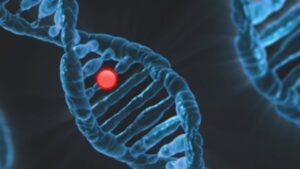
Even a single change in your dog’s DNA might lead to cancer.
What Kinds of Changes Occur with Genetic Mutations
Genetic mutations may result in no observed change, a minor change, or a major change in gene function.6
For example, a point mutation may change the protein that is made, but that protein may still be able to do the same job as the original one, so there is no difference in results. Or, that protein may be able to do the same thing, but be less effective at it, resulting in a minor change.
In more extreme situations, a mutation may result in a gene that no longer codes for the protein that needs to be made, which causes a loss of function. Or, the gene goes into hyperdrive and makes too much of that protein, which results in gain of function.
The Magical Number Three: In-Frame Mutations and Frameshift Mutations
Recall that amino acids consist of three nucleotides, and these amino acids are the building blocks for the protein that the gene codes for. Biologists call these sequences of “triplet” nucleotide groups a “reading frame.”
A mutation in which the number of nucleotides impacted by a mutation is divisible by three is called an in-frame mutation, because the reading frame number three is still organizing the gene. In-frame mutations may be orderly, but they can still have large consequences because the amino acids in the mutated sequence may not translate to making the correct protein.
But when nucleotides are deleted or inserted in a number not divisible by three, large changes like loss of function and gain of function can result. This is called a frameshift. A frameshift results in a different “reading” of which proteins are to be made.
How Many Genetic Mutations Does It Take to Make a Difference?
One genetic mutation might or might not make a big difference in function. Remember that there are many nucleotides in every gene, and there can be mutations in more than one part of the gene. A single gene might have one or more mutations.
A single kind of cancer can be caused by multiple different kinds of mutations, some of which may occur within the same gene. For example, canine osteosarcoma has been linked to mutations in the P53 tumor suppressor gene and may include point mutations, deletions, and insertions.3
Genetic Mutations and Dog Cancer
Genes govern every part of a cell’s life, and therefore most tasks of cells in organs, and therefore most tasks of organs. This is why mutations in the genes can, sometimes, create conditions where cancer can develop and thrive.
For example, cell growth and division has several moving parts. If just one of the genes involved in this process gets a mutation that results in a gain of function or loss of function, cancer can result.
Once genes associated with cancer are in control, they can code for proteins that act as signals, proteins that act as receptors, proteins that suppress cell growth, or proteins that initiate cell death. In other words, they can do a lot of things a normal, healthy cell can do, but they can also make up their own rules.
Mutations in your dog’s cancer genotype can point to treatments that will be more effective. Dr. Chon explains how the test SearchLight DNA works in this episode of Dog Cancer Answers.
How Genetic Mutations Help Dog Cancer Cells Divide Rapidly and Live Forever
Every cell takes its job of growing and dividing very seriously and has instituted a series of regulatory “checkpoints” (called G1, S, and G2) during interphase (growing and duplicating its own DNA) and mitosis (splitting itself into two new “daughter” cells).
These checkpoints give the cell time to reflect on certain questions as it duplicates and divides:
- Am I healthy?
- Can I do my job?
- Did my DNA replicate correctly?
- Is there a need to make more of me?
- If not, should I not divide?
- If not, should I be destroyed?
Mutations that result in cancer often cause cells to bypass these checkpoints.12 This is why cancer cells continue to divide, even though they are unhealthy or cannot do their original job correctly. They continue to live long past their natural lifespan because they ignore the checkpoint about whether they should destroy themselves.
Genetic Mutations Distort Cellular Communication
A mutation may also affect receptor signaling, and therefore the wrong cues are given to the cell regarding its health and status. This causes the cell to do the “wrong” thing.
For example, 70% of Rottweilers have a missense variant (a point mutation that produces a different amino acid than normal) in the MET gene that affects ligand binding at the C-MET receptor in the cancer cell. This change results in unregulated cell growth.4
Known Genetic Mutations Linked to Dog Cancer
Research on specific mutations known to cause cancer in dogs is lacking compared to what we know about human cancer. However, there are mutated genes that regularly pop up in common dog cancers. Some studies have been able to make correlative conclusions between the mutations noted and the cancer under investigation.
- Osteosarcoma:
- Inherited mutations resulting in frameshift and missense variants in a number of tumor suppressing genes such as TP53, BRCA2, and RB1 have been linked to osteosarcoma8.
- In a study investigating 15 appendicular osteosarcomas, 7 of them had point mutations in the P53 gene. One resulted in a missense mutation and the other resulted in a mutation that was silent (a point mutation that does not affect the sequence of amino acids).3 Interestingly, the location of these mutations was almost identical to that observed in humans.3
- Prostatic carcinoma and urothelial carcinoma:
- A point mutation resulting in a T to A transversion at nucleotide position 1,349 of the BRAF gene was found in 64 of 667 canine primary tumors. A total of 80% of prostatic carcinoma cases and 67% of urothelial carcinoma cases had this mutation.9
- Lymphoma:
- A neutered female Bull Mastiff with lymphoma had an inherited mutation in P53 from a parent that had an insertion of two nucleotides, resulting in a frameshift that caused a premature stop codon.10 This means the genes stopped creating their protein before they should have.
- A cross breed male with lymphoma had a DNA sequence with a point mutation resulting in a base transition in the P53 gene. The mutation caused an amino acid substitution in one of the P53 gene copies while the other copy was completely deleted.10
- A male Collie cross with lymphoma had a DNA sequence with a point mutation resulting in a base transition in the P53 gene that caused a premature stop codon in one of the P53 gene copies while the other copy was completely deleted.10
Do I Need to Know the Genetic Mutations Associated with My Dog’s Cancer?
When your dog has cancer, the genetic mutations that led to it might not have an impact on treatment choices you make. However, knowing which genetic mutations cause different types of cancers leads to new treatments based on those discoveries. As we deepen our understanding of cancer’s genetic origins, we’ll understand how to get better outcomes, as well.
Genetic mutations that directly impact cancer treatment
Genetic mutations not only impact your dog’s cancer risk but can also impact how well cancer related treatments work. For example, a deletion mutation in the MDR1 gene, which makes a protein called p-glycoprotein, results in multidrug resistance mutation 1.14
P-glycoprotein sits on the surface of the cell membrane and works to clear chemicals and toxins that are “bad” out of the brain. If your dog has two working copies of the MDR1 gene, then they’re more resistant to medications because the p-glycoprotein does its job and tosses out chemicals in the medication that it perceives as being bad.
If your dog has one or two mutated copies of the MDR1 gene, then they become more sensitive to the negative effects of medications because p-glycoprotein is lousy at its job, and drugs subsequently build up in the brain to dangerous levels. This means that dogs with the MDR1 mutation can have severe side effects in response to chemotherapy drugs even at low doses, and may not be good candidates for treatment.14
Herding breed dogs have the highest incidence rates of the MDR1 mutation – approximately 70% of Collies have one or two mutated copies of the gene.15 It’s also observed in approximately 50% of Australian Shepherds and Shetland Sheepdogs and 10% of German Shepherds.15
Thankfully, it is relatively easy to test if your dog has the mutation via a cheek swab test kit submitted to a lab.15
Dogs with the MDR1 mutation can have severe side effects in response to chemotherapy drugs even at low doses.
Although the MDR1 mutation in dogs is known for making dogs more susceptible to negative outcomes associated with chemotherapeutic drugs, the unmutated wild-type MDR1 gene is also known for developing resistance to chemotherapeutic drugs, eventually building up a tolerance that makes them ineffective as a cancer treatment tool.
In a study that examined the expression level of the MDR1 gene in 27 dogs with malignant lymphomas receiving chemotherapy, dogs who exhibited severe side effects from chemotherapy had lower levels of MDR1 expression than dogs who tolerated chemotherapy well.16 The four dogs who had the highest levels of MDR1 expression showed the greatest degree of disease progression, suggesting that MDR1 was working a little too well, and tossing out the chemotherapeutic drugs before they could have any effect on cancer cells.16
Research along these lines has taken off in human studies as part of several different initiatives to better understand underlying genetic mechanisms responsible for chemotherapy resistance. Multiple lines of resistance involving distinct genetic mechanisms have been found.
For example, individual mutations in the ASXL1, SETBP1, and RELN genes have all been connected to resistance to chemotherapeutic drugs in pediatric acute myeloid leukemia in humans.19
Dogs likely have a similar variety of mutations linked to drug resistance, though they aren’t as well understood as they are in humans.
Geneticist Dr. Charlotte Hacker explains how cells check up on themselves to make sure they should (or shouldn't) replicate.
Oncogenes
Mutations can occur in any gene, but things get serious in regard to cancer when they happen in tumor suppressor genes or proto-oncogenes.18
These are genes that are involved in starting and stopping cell division. If a mutation occurs in one of these genes that causes it to not work correctly, then cell division can go haywire, resulting in cancer.
You may also hear the word oncogene, which is just a proto-oncogene that has a mutation capable of contributing to unregulated cell growth.
It is important to note that mutations in these kinds of genes do not always lead to cancer. Things are a bit more complex than that, and depend on all sorts of factors such as the function of the gene, the type of mutation, and how much that mutation impacts that gene’s function.18
Specific mutations connected to particular types of cancer are not well studied in dogs, but some examples do give owners an opportunity to get ahead and take preventative measures.
For example, German Shepherds commonly develop kidney cancer due to a specific mutation in the BHD gene.17 You as an owner can easily have your veterinarian test for the presence of this mutation, and then be on alert and get regular tests of kidney healthy done to catch the cancer early if it does develop.
- American Cancer Society. (2022). Gene changes and cancer. Genes and Cancer. https://www.cancer.org/healthy/cancer-causes/genetics/genes-and-cancer/gene-changes.html.
- Boston University School of Public Health (BU). (2003). The Biology of Aging. The Birth and Death of Cells. https://sphweb.bumc.bu.edu/otlt/mph-modules/ph/aging/mobile_pages/Aging2.html.
- Johnson, A.S., Couto, C.G., & Weghorst, C.M. (1998). Mutation of the p53 tumor suppressor gene in spontaneously occurring osteosarcomas of the dog. Carcinogenesis, 19, 213-217.
- Leao, A.T., McMahon, M., & London, C.A. (2006). Identification of a novel germline MET mutation in dogs. Animal Genetics, 37, 248-252.
- Lee, Y.C.G., & Langley, C.H. (2010). Transposable elements in natural populations of Drosophila melangaster. Philosophical Transactions of the Royal Society B, 365, 1219-1228.
- Loewe, L. (2008). Genetic mutation. Nature Education, 1, 113
- Loewe, L., & Hill, W.G. (2010). The population genetics of mutations: good, bad and indifferent. Philosophical Transactions of the Royal Society B, 365, 1153-1167.
- Gardner, H.L., Sivaprakasam, K., Briones, N., Zismann, V., Perdigones, N., Drenner, K., … & Hendricks, W.P.D. (2019). Canine osteosarcoma genome sequencing identifies recurrent mutations in DMD and the hisone methyltransferase gene SETD2. Communications Biology, 2, 226.
- Mochizuki, H., Kennedy, K., Shapiro, S.G., & Breen, M. (2015). BRAF mutations in canine cancers. PLoS ONE, 10(6), e0129534.
- Veldhoen, N., Stewart, J., Brown, R., & Milner, J. (1998). Mutations of the p53 gene in canine lymphoma and evidence for germ line p53 mutations in the dog. Oncogene, 16, 249-255.
- The genetics of cancer. Cancer.Net. https://www.cancer.net/navigating-cancer-care/cancer-basics/genetics/genetics-cancer. Published June 23, 2021. Accessed December 15, 2022.
- Molinari M. Cell cycle checkpoints and their inactivation in human cancer. Cell Proliferation. 2000;33(5):261-274. doi:10.1046/j.1365-2184.2000.00191.x
- Essentials of Cell Biology, Unit 2; Protein Function. Scitable by Nature Education. https://www.nature.com/scitable/ebooks/essentials-of-cell-biology-14749010/122996980/. Accessed December 20, 2022.
- Hunter T. Multidrug Resistance Mutation (MDR1). VCA Animal Hospitals. https://vcahospitals.com/know-your-pet/multidrug-resistance-mutation-mdr1. No publication date available. Accessed December 23, 2022.
- Connors R. MDR1 Genetic Testing: What You Need to Know. Today’s Veterinary Nurse. https://todaysveterinarynurse.com/clinical-pathology/mdr1-genetic-testing/. September 1, 2017. Accessed December 23, 2022.
- Gramer I, Kessler M, Geyer J. Determination of MDR1 gene expression for prediction of chemotherapy tolerance and treatment outcome in dogs with lymphoma. Vet Comp Oncol. 2015;13(4):363-372. doi:10.1111/vco.12051
- Tschirgi, M. Inherited cancer in dogs. NeoGen Paw Print Genetics. https://www.pawprintgenetics.com/blog/2014/04/21/inherited-cancers-dogs/. April 21, 2014. Accessed December 23, 2022.
- Bell, J.S. (2003). The genetics of canine cancer. Canine and Feline Breeding and Genetic Conference. October 2-4, 2003. Sturbridge, Massachusetts. https://www.vin.com/apputil/content/defaultadv1.aspx?meta=Generic&pId=11165&id=3848656#:~:text=Most%20tumor%2Dsuppressor%20genes%20only,the%20production%20of%20cancer%20cells.
- Rasche M, Zimmermann M, Borschel L, Bourquin JP, Dworzak M, Klingebiel T, et al. Successes and challenges in the treatment of pediatric acute myeloid leukemia: a retrospective analysis of the AML-BFM trials from 1987 to 2012. Leukemia. 2018;32:2167–77.
Topics
Did You Find This Helpful? Share It with Your Pack!
Use the buttons to share what you learned on social media, download a PDF, print this out, or email it to your veterinarian.

